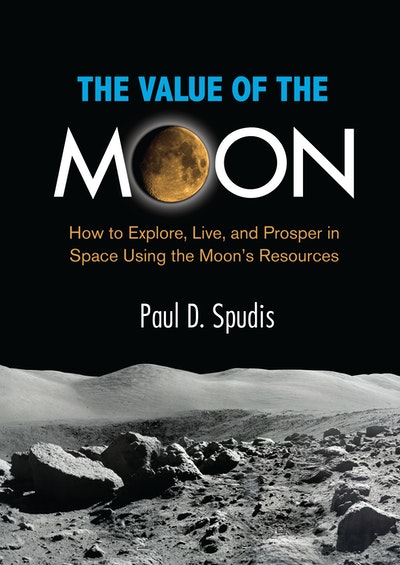- Published: 3 May 2022
- ISBN: 9781588345646
- Imprint: Smithsonian Books
- Format: Paperback
- Pages: 256
- RRP: $34.99
The Value of the Moon
How to Explore, Live, and Prosper in Space Using the Moons Resources
- Published: 3 May 2022
- ISBN: 9781588345646
- Imprint: Smithsonian Books
- Format: Paperback
- Pages: 256
- RRP: $34.99
"It holds the secrets of our distant past. It is the key to our future in space. And best of all, it is right next door. In this compelling book, one of the world's top lunar scientists shows why, if we really want to get to Mars, we must begin on the Moon." -- Andrew Chaikin, author of A Man on the Moon “A lucidly written exploration of why the Moon has always been part of our culture and how it could be humanity’s future home and resource base.” -- Francis French, co-author of Falling to Earth and author of In the Shadow of the Moon “Paul Spudis provides a compelling rationale of why the Moon constitutes America’s critical stepping stone into deeper regions of space. As Dr. Spudis clearly articulates, any successful mission to Mars requires the development of the Moon, which would also provide a long-term fusion energy resource for the Earth and space propulsion.” -- Harrison H. Schmitt, Apollo 17 astronaut, geologist, former U.S. Senator KIRKUS REVIEWS Renowned geologist and lunar scientist Spudis (Blogging the Moon, 2011, etc.) makes a compelling argument that the moon's many available resources may jump-start mankind's pursuit of space travel. In the late 2000s, the news that the moon holds millions, possibly billions, of tons of ice at each pole stunned and excited the space science community. Ice is invaluable for two major reasons: it can be melted into liquid water, and its constituent parts (hydrogen and oxygen) can be harnessed and converted to rocket fuel. Additionally, lunar probes show that small areas near each pole are illuminated by the sun for most of the year, making them ideal locations for solar arrays to generate usable energy. The author writes that the lunar "resource bonanza" is tantalizing to those who hope to send humans back to the moon and beyond, as it eliminates the need for such resources to be hauled in from Earth. In approachable if at times technical prose, Spudis argues that the moon has everything we need to build a permanent moon base and that doing so can lay the foundation of a space transportation network. In fact, he argues that a manned trip to Mars may only be feasible if we establish a launch pad on the moon. To contextualize such an endeavor, this book is packed with historical, political, and cultural history about mankind's on-again, off-again relationship with the moon, a saga in which the author has been intimately entwined. Spudis also provides a literal road map to settling on the moon that is tremendously exciting to ponder. The author's deep knowledge and contagious opt imism—even in the face of considerable government bureaucracy—make for fascinating reading that, happily, is not science fiction. A readable book sure to charm and thrill anyone interested in space exploration. BOOKLIST Since Spudis’ prior popular work, The Once and Future Moon (1996), there has been a startling discovery: Earth’s closest celestial neighbor has water. Involved in the research into this revelation, Spudis summarizes the evidence as a prelude to this book’s main argument: that the objective of America’s human spaceflight program should be a permanent presence on the moon. NASA is intent, instead, on reaching an asteroid or Mars. Criticizing those destinations for scientific and technical reasons, Spudis also asserts that NASA will never receive enough money for these destinations. Thus, space policy ought to refocus on the moon because, in Spudis’ repeated, slogan-like phrase, “it’s close, it’s interesting, and it’s useful.” Presenting a methodical plan to establish a base, Spudis insists his ideas are within NASA’s budget. If frugality doesn’t convince them, Spudis suggests a strategic competition, noting that there is a new race to the moon with just one



